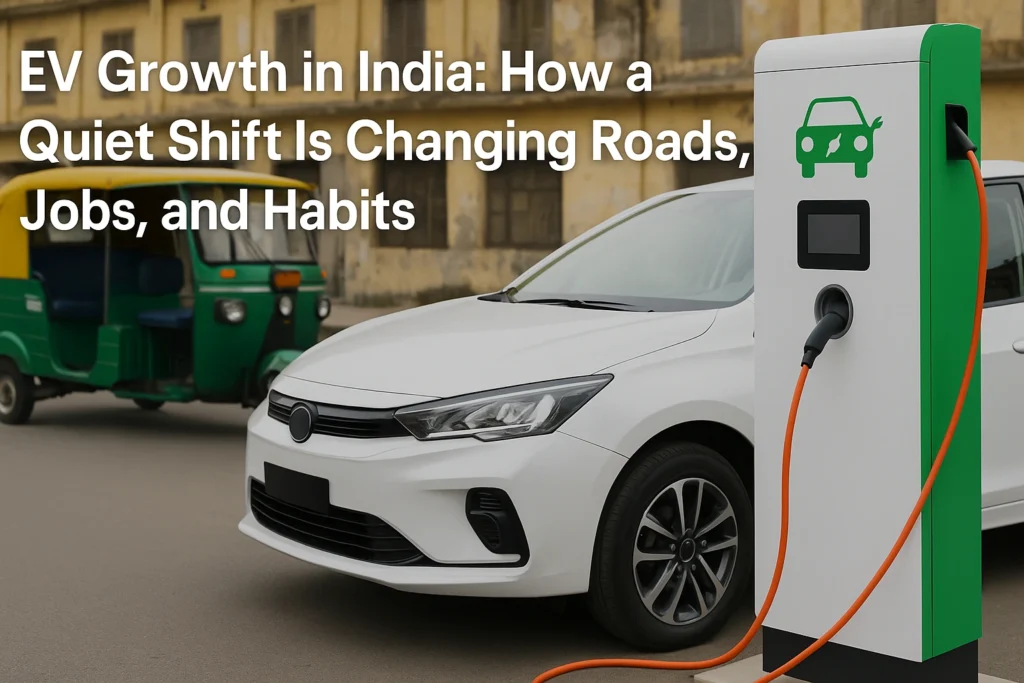EV Growth in India: How a Quiet Shift Is Changing Roads, Jobs, and Habits

A white electric car charges at a public station as a traditional auto-rickshaw passes by—capturing India's evolving mobility landscape.
Table of Contents
EV growth in India is no longer a prediction—it’s reality unfolding in silence. Across city alleys and small-town roads,“EV growth in India is steadily replacing petrol-powered engines”. But this change isn’t loud or dramatic—it’s personal, economic, and deeply rooted in everyday decisions.
Not a Revolution. More Like a Recalibration.
You don’t really notice it until you do. One day you’re riding in an e-rickshaw that feels quieter than usual. The next, your neighbor’s son is charging his new scooter with a plug that snakes out from the second-floor balcony. No press releases, no grand unveilings. And yet, EV growth in India is underway. Quiet, steady, and remarkably human.
When people imagine an electric vehicle wave, they often picture highways full of sleek Teslas. That’s not what’s happening here. India’s EV story is made up of two-wheelers, shared autos, and delivery riders swapping batteries behind kirana stores. Not glamorous, but deeply transformational.
People Aren’t Going Electric for the Planet
“I don’t think about climate change,” a food delivery rider in Ahmedabad told me while plugging in his e-scooter outside a chai stall. “But I don’t spend ₹150 a day on petrol anymore. That’s enough reason.”
There’s the truth of it. For most Indians, this shift isn’t ideological—it’s practical. When fuel prices climb, and incomes stay flat, even ₹500 in monthly savings starts to matter. And EVs are delivering that. In real, tangible ways.
It’s the Small Cities Where the Change Feels Raw
Delhi and Mumbai grab the headlines, but go to places like Nashik, Ranchi, or Tirupati, and you’ll see it more clearly. E-rickshaws moving students, women riding e-scooters to work, and shopkeepers charging vehicles with patched-together solar setups.
Adoption is slower in rural areas, yes. But it’s not stagnant. The questions are different there. “Will it last five years?” “Can I fix it at the local garage?” These aren’t anti-tech people—they’re cautious, and for good reason. Access to charging remains patchy, and information even more so.
Still, curiosity is growing. People watch. They ask questions. And one by one, they decide to try.
The Infrastructure Lag Is Real—and Felt
“This mismatch between charging infrastructure and demand highlights one of the biggest growing pains of EV growth in India“. Walk through a metro station parking lot in Bengaluru, and you’ll spot a couple of dusty EV chargers. Sometimes they work, sometimes they don’t. In housing societies, the lucky ones have installed private setups. Others are stuck waiting hours at public spots with queues that rival a COVID testing center.
Government estimates say there are 12,000 public chargers now, but good luck finding one in a village or small town. Still, companies like Tata Power and ChargeZone are trying to change that, placing fast chargers at petrol pumps, malls, and apartment complexes.“Rural areas are slowly joining the electric transition, signaling how EV growth in India is beginning to move beyond metros.”
External Link → Tata Power Charging Network
It’s slow work, but it’s happening.
Startups Are Building a New Middle Layer
“Local startups aren’t just selling vehicles—they’re becoming vital players in shaping EV growth in India.”Ather Energy, Ola Electric, Euler Motors. These aren’t just companies—they’re builders of a parallel auto industry. They’re not just making vehicles, but imagining a system where repair, resale, servicing, and charging all feel normal—even expected.
Most Indians don’t trust new tech easily. So these firms are doing more than selling EVs. They’re selling reassurance. That you can rely on this machine. That it won’t leave you stranded. That someone will fix it if it breaks down.
Battery swapping is emerging too. Especially for fleet and delivery businesses. No downtime, no waiting. Just swap and go. SUN Mobility is betting on this model, and so far, it looks smart.
The Government Is Playing the Long Game
Credit where it’s due—without the government’s push, none of this would have happened. The FAME II scheme and state-level subsidies brought prices down. The PLI scheme is helping build local battery manufacturing. And NITI Aayog’s vision of 30% EV penetration by 2030? Surprisingly, it’s not out of reach anymore.
External Link → NITI Aayog EV Vision
Still, the policy needs more bite. We need better resale mechanisms. Financing options for second-hand EVs. And insurance coverage that doesn’t penalize uncertainty.“The Production-Linked Incentive (PLI) scheme aims to support domestic battery production, which is crucial for sustaining long-term EV growth in India.”
What People Won’t Tell You (But Feel)
There’s a hesitation many people feel but don’t admit. A sense that this is too new, too untested. What if EVs are just a passing thing? What if they don’t last?
That’s why you see people riding petrol bikes for backup, or asking neighbors for reviews before they buy. Trust takes time to build. And it’s being built—through shared experience more than brand messaging.
So Where Are We Headed?
By 2026, India will likely see EVs dominating the two-wheeler space. Fleet electrification—especially for delivery and urban transport—will spike. Tier-2 cities will become the new battleground. And charging infrastructure, while still patchy, will finally become visible outside metros.
But don’t expect a revolution. Expect a slow turn of the wheel. That’s the Indian way—one foot in the familiar, the other testing the future.
You may also like ( India Clean Energy Surge )
Final Thoughts: EVs as Everyday Objects
You know a product has arrived when it stops being talked about. And that’s where EVs are headed in India. Soon, they’ll be as boring—and essential—as a fridge or ceiling fan. Just part of life.
EV growth in India isn’t a spectacle. It’s a quiet story of budget calculations, roadside advice, and a thousand personal experiments. Not the stuff of headlines—but definitely the stuff of change.“From policy shifts to middle-class buying patterns, EV growth in India represents more than a technology change—it’s a cultural shift.”





